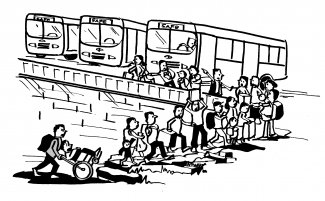Submitted by ManuelRothe
on Tue, 11/05/2019 - 17:56
Physical barriers in shelters or safe spaces prevent people with limited mobility from reaching safety in disaster situations, when the situation is chaotic, and people are separated from families or assistants.
Overcoming physical barriers has four relevant components from the perspective of the user:
- How to reach an area, site or structure
- How to enter the structure and its parts
- How to circulate/move inside the structure
- How to use the structure and its facilities
When planning, designing, building or retrofitting physical sites and structures consider:
- The area or site is flat, accessible, and cleared from obstacles, like rubble and debris.
- Pathways leading to the main entrance of the structure are accessible and cleared from obstacles.
- The main entrance is possible to reach for persons with different types of disability, with the possibility to install a ramp.
- Handrails on ramps, walkways and stairs are installed to provide support and safety.
- Openings (e.g. doorways) are at least 90 cm wide, for a wheelchair to pass through.
- Entrances have contrasting colour to make it easier for persons with visual impairment to identify them.
- Doors and windows are accessible for wheelchair users and easy to open and close for persons with physical limitations.
- Space inside the structure is wide enough to allow a wheelchair user to circulate and complete a full turn.
- Electrical lighting has been provided to increase accessibility and safety.
- Other measures to increase the safety of the shelter have been considered, such as fastening furniture, or avoiding sharp edges in hygiene areas.
- Work surfaces are accessible, with seats or possibility to rest nearby.
- Accessible sanitary facilities are available in or in proximity of the structure. Toilets are equipped with a seat at a height of 45-50cm and a grab bar to facilitate the transfer.
- Door is easy to open and close for persons with physical disabilities, older persons and children.
- Basic thermal comfort (not too hot in hot climates and not too cold in cool climates) is provided.
Remember: Inaccessible structures are often the result of a lack of awareness of architects, planners and developers of the need for access or the misperception that accessible building requires a lot of cost or technical expertise. Removing physical barriers contributes to an inclusive society and is an investment for all.

©Julie Smith
Sources